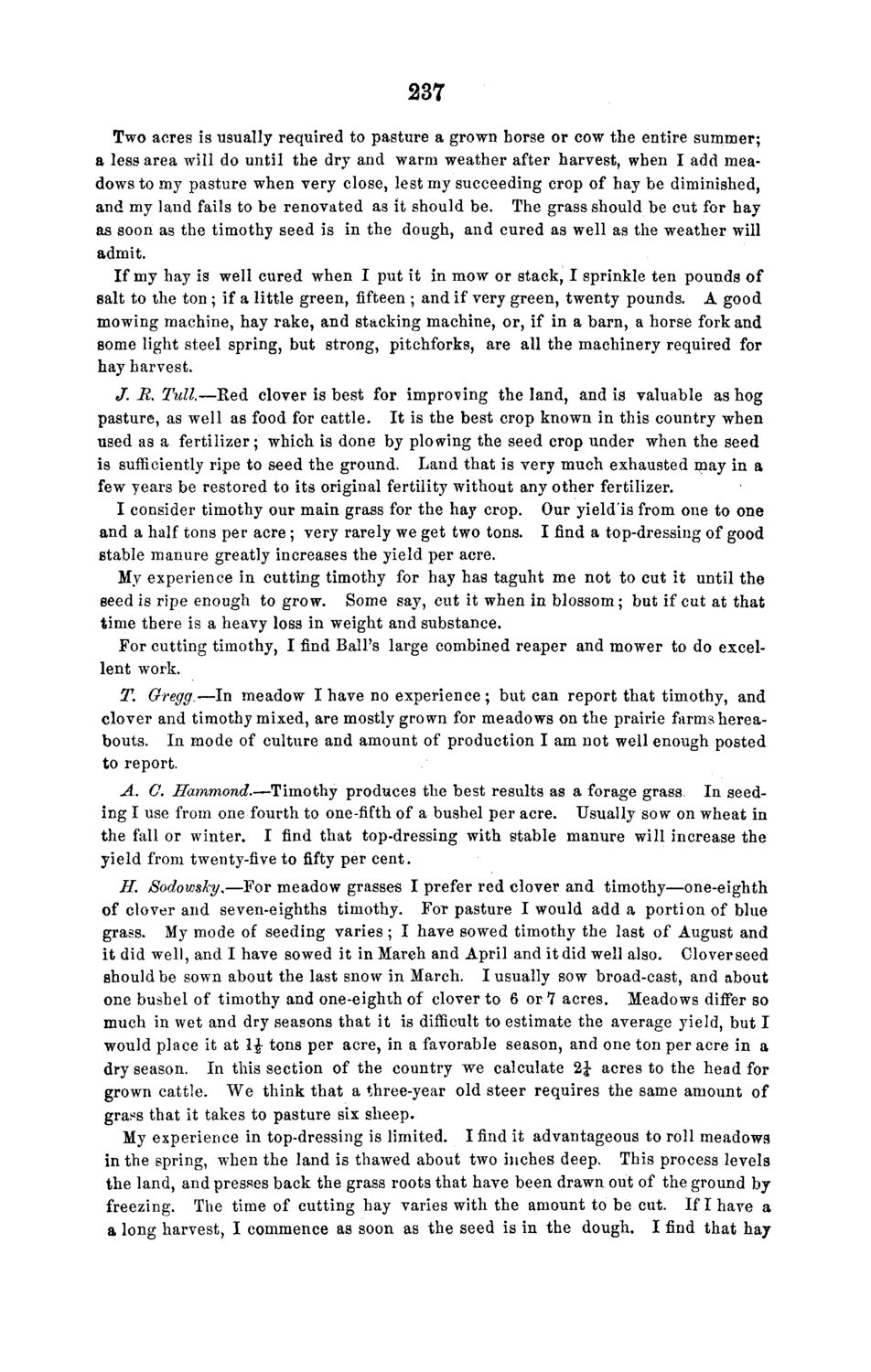| |
| |
Caption: Board of Trustees Minutes - 1868
This is a reduced-resolution page image for fast online browsing.

EXTRACTED TEXT FROM PAGE:
237 Two acres is usually required to pasture a grown horse or cow the entire summer; a less area will do until the dry and warm weather after harvest, when I add meadows to my pasture when very close, lest my succeeding crop of hay be diminished, and my land fails to be renovated as it should be. The grass should be cut for hay as soon as the timothy seed is in the dough, and cured as well as the weather will admit. If my hay is well cured when I put it in mow or stack, I sprinkle ten pounds of salt to the ton ; if a little green, fifteen ; and if very green, twenty pounds. A good mowing machine, hay rake, and stacking machine, or, if in a barn, a horse fork and gome light steel spring, but strong, pitchforks, are all the machinery required for hay harvest. J. & Tull.—Red clover is best for improving the land, and is valuable as hog pasture, as well as food for cattle. It is the best crop known in this country when used as a fertilizer; which is done by plowing the seed crop under when the seed is sufficiently ripe to seed the ground. Land that is very much exhausted may in a few years be restored to its original fertility without any other fertilizer. I consider timothy our main grass for the hay crop. Our yield'is from one to one and a half tons per acre ; very rarely we get two tons. I find a top-dressing of good stable manure greatly increases the yield per acre. My experience in cutting timothy for hay has taguht me not to cut it until the seed is ripe enough to grow. Some say, cut it when in blossom; but if cut at that time there is a heavy loss in weight and substance. For cutting timothy, I find Ball's large combined reaper and mower to do excellent work. T. Gregg.—In meadow I have no experience; but can report that timothy, and clover and timothy mixed, are mostly grown for meadows on the prairie farms hereabouts. In mode of culture and amount of production I am not well enough posted to report. A. O. Hammond.—Timothy produces the best results as a forage grass In seeding I use from one fourth to one-fifth of a bushel per acre. Usually sow on wheat in the fall or winter. I find that top-dressing with stable manure will increase the yield from twenty-five to fifty per cent. H. Sodowsky.—For meadow grasses I prefer red clover and timothy—one-eighth of clover and seven-eighths timothy. For pasture I would add a portion of blue grass. My mode of seeding varies; I have sowed timothy the last of August and it did well, and I have sowed it in March and April and it did well also. Clover seed should be sown about the last snow in March. I usually sow broad-cast, and about one bushel of timothy and one-eighth of clover to 6 or 7 acres. Meadows differ so much in wet and dry seasons that it is difficult to estimate the average yield, but I would place it at l^ tons per acre, in a favorable season, and one ton per acre in a dry season. In this section of the country we calculate 2J acres to the head for grown cattle. We think that a three-year old steer requires the same amount of grass that it takes to pasture six sheep. My experience in top-dressing is limited. I find it advantageous to roll meadows in the spring, when the land is thawed about two inches deep. This process levels the land, and presses back the grass roots that have been drawn out of the ground by freezing. The time of cutting hay varies with the amount to be cut. If I have a a long harvest, I commence as soon as the seed is in the dough. I find that hay
| |